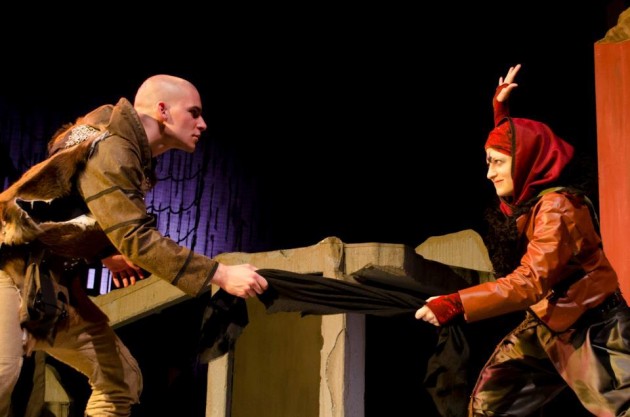
The Western Carolina University School of Stage and Screen presented “Rashomon” at 7:30 p.m. every night between Feb. 20 and 23 in Hoey Auditorium. Under the direction of D.V. Caitlyn, Thursday night’s performance was a post-apocalyptic thrill for the entire 90-minute show.
The play, written by Fay and Michael Kanin, is based on the film version of “Rashomon” by Akira Kurosawa, who based it on stories written by RyÅnosuke Akutagawa. It is famous among psychologists because it gave the name to the “Rashomon Effect.” According to the program, psychologists define the “Rashomon Effect” as the way different people might recall the same event in very different ways-and that all observers of the event are convinced that their version of the story is the absolute truth.
Michael Nichols said, “It was an interesting concept.”
In “Rashomon,” four people are part of and/or witness a rape and murder, and all of them have their own version of what exactly happened in the bamboo forest. In the original play, everything takes place in a bamboo forest in feudal Japan, but due to some creative changes, this play was put into a post-apocalyptic Japan, though still in a bamboo forest.
The show opened with a group of children playing tag in the forest that became the setting for the play. A severe storm freezes the children and knocks the lights out. When the lights came back on, where the children stood, there now stand six figures in all black, known as the “Noh ones.”
Katelyn Baucom, Katie Perez, Sarah Luckado, Alexander Quitman Volpi, Joe Watson and Wesley Gonzales played the Noh ones. They reminded student Rachel Bodenhamer of the demons at the Rashomon Gate from the Kurosawa movie.
The Noh ones crawl around the set, arranging themselves into the background, and the play truly begins with a discussion between a Buddhist priest, played by junior Grant Hengeveld, and a woodcutter, played by freshman Alex Drost, both of whom just came from the police proceedings about the aforementioned crime.
The Buddhist priest, due to the savagery of everything that happened, becomes irrationally angry and decides to leave the priesthood, which the woodcutter wants to prevent, and they stop at the Rashomon Gate while they wait for the rain to pass. They talk and are set upon by a wigmaker, who takes the hair for her wigs from “only the finest corpses” at the gate and loves gossip. Once she hears about the trial, she wants to hear all of the details.
The first witness who is called was the bandit Tajomaru, played by sophomore Cullen Ries. Tajomaru was accused of the murder of a samurai, and the rape of his wife, both of which he confesses to easily. According to his version of the story, the wife was spirited, fighting back and demanding that her husband be allowed to fight for her honor. He swears that the husband fought him and lost fairly, saying that he was one of the only men to ever cross swords with Tajomaru more than fifteen times, even.
The next witness that was called was the wife, Kinume, and her mother. Senior Jaclyn Helms played Kinume, and Emily Pears played the mother. These two told the story in a different manner. They showed a kitchen maid’s daughter, who married a samurai and had tried very hard to be everything that he needed her to be, despite her low birth. In her version, she was significantly frailer than Tajomaru’s tale had described her, and she was very much in love with her husband. She claimed that she asked her husband to kill her in order to restore her lost honor, but that he refused.
The next witness was a medium, played by junior Amanda Wilson, who with the help of the Noh ones, summoned the spirit of the dead samurai husband. Senior Jordan Snead, as the husband, claimed that after Kinume was raped, she told the bandit to kill her husband so that she could escape, but that the bandit refused. The husband’s dead spirit said that he then killed himself because of his loss of honor.
The woodcutter and priest are lamenting the fact that justice will never be served because of the differences in stories of all three witnesses. As the wigmaker, brilliantly played by senior Hannah Chatham, put it, “It’s simple. Everyone tells what they want the world to believe.”
As you can see, none of these stories quite match up. That’s because none of the stories are strictly true. In a shocking turn of events, it turns out that the woodcutter saw the entire tragedy occur, and his story reveals the truth, which is a combination of what the other characters had said.
All of the preparation and training that went into putting this show together made everything fit to become the amazing show that it turned out to be. Director D.V. Caitlyn’s aesthetic divergences and stylistic tweaks, along with the superb acting and tech team, took this show from merely an interesting concept to a spectacular performance. Even with one of the actors getting injured prior to the show’s opening, the production went smoothly.
The choreography was amazing, and you could tell that some of the moves that they used had taken serious work to be able to perform. Several of the actors had been training for the choreography since the summer of 2012.
After the performance, stage manager Deanna Braine said, “We had a lot of injuries and mishaps, but the cast came together and supported each other throughout the process and on opening night. I think it was a really great experience, getting to work on such a high concept show.”






